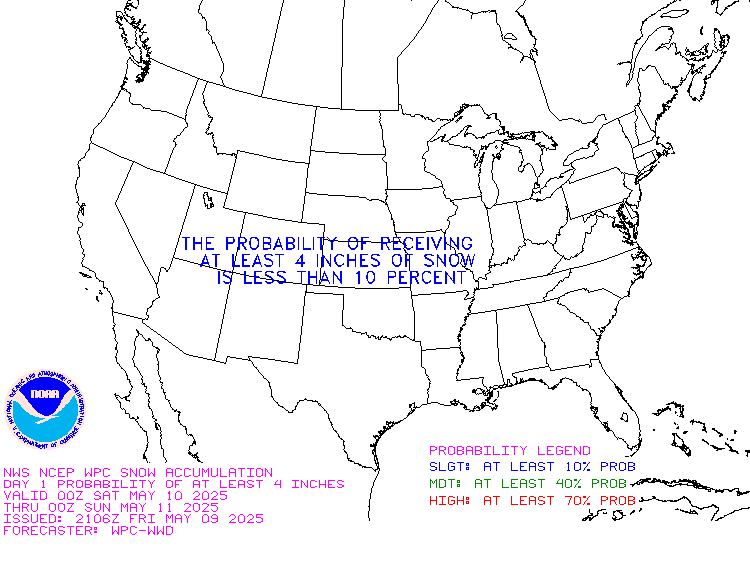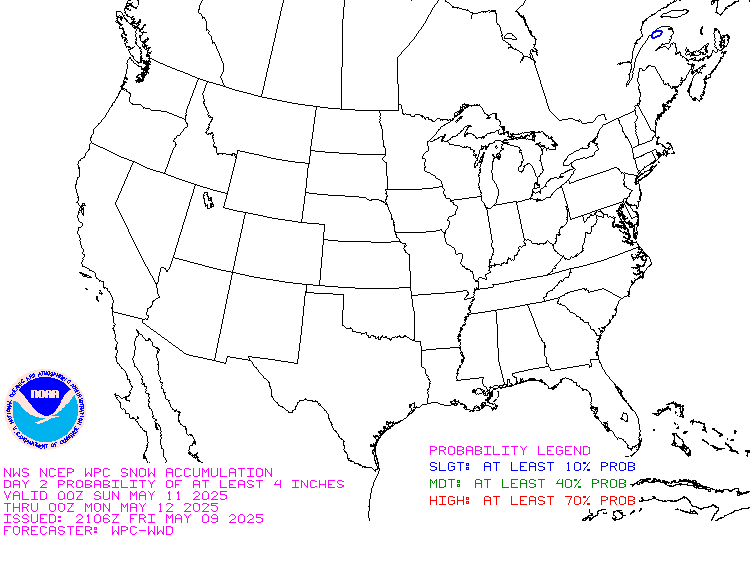It is difficult to find a more comprehensive Weather Outlook anywhere else with the ability to get a local 10-day Forecast also.
This article focuses on what we are paying attention to in the next 48 to 72 hours. The article also includes weather maps for longer-term U.S. outlooks and a six-day World weather outlook which can be very useful for travelers.
First the NWS Short Range Forecast. The afternoon NWS text update can be found here but it is unlikely to have changed very much. The images in this article automatically update.
Short Range Forecast Discussion
NWS Weather Prediction Center College Park MD
Sat Apr 13 2024
Valid 12Z Sat Apr 13 2024 – 12Z Mon Apr 15 2024…Heavy lower elevation rain, mountain snow, and gusty winds forecast for
California……Shower and thunderstorm chances from the Great Lakes into the Northeast
this weekend, with a threat for some severe weather in the Upper Ohio
Valley/central Appalachians Sunday……Well above average temperatures across the Interior West/central U.S.
Saturday expand to the East Coast Sunday…A deep upper-level closed low and associated surface frontal system
approaching the California coast this morning will be the dominant driver
of hazardous weather for the country for at least the next several days.
Pacific moisture flowing inland will bring moderate to locally heavy lower
elevation coastal/valley rain showers and thunderstorms to portions of the
Pacific Northwest and California Saturday. The heaviest rain totals are
expected where the moist flow intersects favorable upslope regions along
the central Coastal Ranges into the Transverse Ranges and northern/central
Sierra, and some isolated instances of flooding could occur. Rainfall
amounts overall should come down into the day Sunday as the system moves
further inland and the influx of moisture from the ocean decreases.
However, some locally heavy amounts are once again possible, particularly
for the Transverse Ranges where wet antecedent conditions from the prior
days rainfall will bring another risk of some isolated flooding. In
addition to rainfall, higher elevations in the northern Coastal Ranges,
Klamath Mountains, and Sierra Nevada will see some moderate snowfall
accumulations, with Winter Weather Advisories in place. Much cooler air
settling in following the passage of the cold front and with the deep
upper-low overhead will even lead to some snow for higher elevations in
the mountains around greater Los Angeles. Some light to moderate lower
elevation rain showers and higher elevation snow will also spread into the
Great Basin Saturday and northern Great Basin/Rockies Sunday. Otherwise,
conditions in vicinity of the system will be rather dry as it pushes
through the Rockies and into the Plains by Monday morning, with a renewed
threat for more widespread showers and thunderstorms, including some
severe weather, later Monday just beyond the current forecast period.
Winds will also be rather gusty as the system passes through the West.Some lingering areas of light to moderate showers continue this morning
across portions of the Great Lakes/Interior Northeast, rotating around a
deep cyclone located in southeastern Canada. Some higher elevations of the
Appalachians may see some snow mix in. Gusty winds will remain in place as
well. Shower chances should taper off into the day as the cyclone moves
away from the U.S. However, a clipper-like system dropping southeast from
Canada will bring a renewed chance of moderate showers and thunderstorms
Sunday to the Interior Northeast, Lower Great Lakes, Upper Ohio Valley,
and central/northern Appalachians. A strengthening upper-level wind field
will overlap enough surface moisture/buoyancy to lead to the threat of
some severe thunderstorms, with a Slight Risk (level 2/5) from the Storm
Prediction Center from eastern Ohio into central Pennsylvania. Damaging
winds will be the main threat, though some large hail and a tornado or two
will be possible as well.A broad area of high temperatures 10-20 degrees above average will expand
from the Interior West/Plains into the eastern U.S. this weekend as an
upper-level trough departs the East Coast. Some of the greatest anomalies
will be over portions of the northern/central Plains on Saturday, where
highs into the 80s are upwards of 20-30 degrees above average. A few near
record-tying/breaking highs will be possible Sunday across parts of the
central/southern Plains into the Middle Mississippi Valley as highs reach
into the mid-80s to low 90s. The combination of warmer temperatures as
well as dry antecedent conditions and gusty winds have prompted an
Elevated Risk of Fire Weather (level 1/3) from the Storm Prediction Center
for portions of the central/southern High Plains Saturday and Sunday. In
contrast, highs will be cool and well below average in California
Saturday, spreading into portions of the central Great Basin and Desert
Southwest Sunday, as the Pacific system pushes inland.
To get your local forecast plus active alerts and warnings click HERE and enter your city, state or zip code.
Above is a 72 hour animation of the forecast. Learn about wave patterns HERE.
Then, looking at the world and of course, the U.S. shows here also. Today we are looking at precipitation.
Please click on “Read More” below to access the full Daily Report issued today.
| Notices: What would you like to learn about? Please provide that to me via the comment section at the end of the article. |
Now more detail on the 48-Hour Forecast (It is a 48 to 72 Hour Forecast actually)
Daily weather maps. The Day 1 map updates twice a day and the Day 2 and 3 maps update only once a day. These maps update automatically. But if that does not happen, you can get updates by clicking HERE
TODAY (or late in the day the evening/overnight map will appear) (Key to surface fronts shown on maps and you will then also be able to insert a city name or zip code and get a local NWS forecast).
TOMORROW
NEXT DAY
This animation shows how things may play out over the next 60 hours. To update click here.
The NWS Climate Prediction Center’s: Watches, Warnings, and Advisories plus other information can be found HERE. We post at least one of those updates daily, sometimes both. The Highlights are shown in the lede paragraph of this article.
ATMOSPHERIC RIVERS
This tells us what is approaching the West Coast. Click HERE to update If I have not gotten around to doing the update. Here is some useful information about Atmospheric Rivers.
Below is the current five-day cumulative forecast of precipitation (Updates can be found HERE)
Ski SnowReports
New Feature – Ski Reports. It is difficult to find reports that auto-update on-screen (and they are very long) but these links will get you to them – If you have additional suggestions make them in the comments section after every Econcurrents Article and we may add those links. We will try to not have too much overlap as that can add to the confusion.
Snow Forecasts. And remember this shows natural snow. Ski resorts also make their own snow.
Day 1

Day 2

Additional snow information can be found here, here, here, and here. The second link provides animations.
Now we look at Intermediate-Term “Outlook” maps for three time periods. Days 6 – 10, Days 8 – 14, and Weeks 3 and 4. An outlook differs from a forecast based on how NOAA uses these terms in that an “outlook” presents information as deviation from normal and the likelihood of these deviations.
Below are the links to obtain updates and additional information. They are particularly useful if you happen to be reading this article significantly later than when it was published. I always try to provide readers with the source of the information in my articles. These links may also be useful for those viewing this article on a cell phone or other small screen.
| Days 6 – 10 (shown in Row 1) | Days 8 – 14 (Shown in Row 2) | Weeks 3 and 4 (Shown in Row 3 but updates only on Fridays) |
| https://www.cpc.ncep.noaa. gov/products/predictions/610day/ | https://www.cpc.ncep .noaa.gov/products/predictions/814day/ | https://www.cpc.ncep.noaa.gov/products/predictions/WK34/ |
Showing the actual maps. They should now update automatically. The Week 3 – 4 Outlook only updates on Fridays. So below is what I call the Intermediate-term outlook. On Fridays, it extends out 28 Days. That declines day by day so on Thursday it only looks out 22 days until the next day when the Week 3 – 4 Outlook is updated and this extends the outlook by one additional week.
| 6–
10
|
|
|
| 8–
14 |
|
|
| 3–
4 |
|
|
HAZARDS OUTLOOKS
Click here for the latest complete Day 3 -7 Hazards forecast which updates only on weekdays. Once a week probably Monday or Tuesday I will update the images. I provided the link for readers to get daily updates on weekdays. Use your own judgment to decide if you need to update these images. I update almost all the images Friday Night for the weekend edition of this Weather Report. So normally readers do not need to update these images but if the weather is changing quickly you may want to.
Temperature month to date can be found at https://hprcc.unl.edu/products/maps/acis/MonthTDeptUS.png
Precipitation month to date can be found at https://hprcc.unl.edu/products/maps/acis /MonthPNormUS.png
World Forecast [that website is has been intermittent so be patient]
Below are the Day 1 -3 and 4-6 forecasts for temperature and precipitation. Updates and much additional information can be obtained HERE
World Temperature Anomalies
World Accumulated Precipitation
This information is provided by the University of Maine. They draw upon many different sources. There is a lot of information available at the link provided. I have just provided two useful forecasts. There are probably over a hundred different forecasts available from this source.
Worldwide Tropical Forecast (This is a NOAA Product)
This graphic updates on Tuesdays) If it has not been updated, you can get the update by clicking here Readers will only have to do that if they are reading this article much later than the date of it being published.
Information on Tropical Storms can be found HERE. Western Pacific information can be found HERE. Note that unless there is an out-of-season storm the below images will not update until the National Hurricane Center starts their seasonal update of these maps on June 1. I include them simply because there can be an out-of-season event in which case it should show up in these maps.


–
| I hope you found this article interesting and useful. |
–
